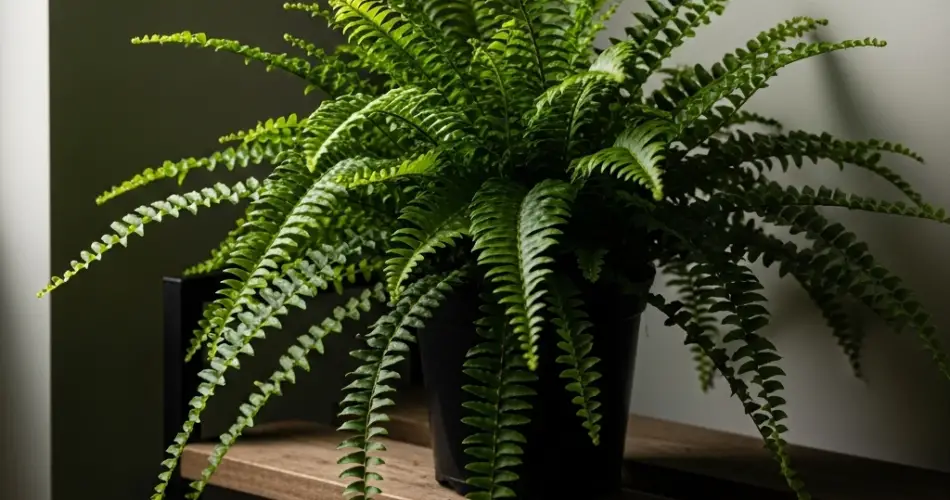The Boston fern (Nephrolepis exaltata) is a classic houseplant known for its graceful arching fronds and lush, green foliage. It’s especially popular for hanging baskets or pedestal planters, instantly adding a touch of elegance to indoor spaces. Although it’s not the most low-maintenance plant, beginners can still enjoy great success with Boston ferns by understanding their basic needs and giving them the right growing environment.
If you’re just getting started with houseplants or want to expand your collection with a fern, here’s everything you need to know about Boston fern care—from lighting and watering to soil and repotting.
Light: Indirect and Gentle
Boston ferns thrive in bright, indirect light. Too much direct sun, especially during the hottest parts of the day, can scorch their delicate fronds. On the other hand, too little light will cause slow growth and sparse foliage.
Best lighting conditions:
-
Near a north or east-facing window.
-
A few feet away from a bright south or west-facing window with a sheer curtain.
-
Outdoors in dappled or filtered light if you’re keeping the plant on a porch or balcony.
Avoid placing the plant in dark corners or direct afternoon sunlight. If leaves begin turning yellow or pale, it may be receiving either too much light or not enough.
Water: Keep It Moist, Not Soggy
Watering is one of the trickiest parts of Boston fern care, especially for beginners. These ferns love consistent moisture but don’t tolerate soggy or waterlogged soil.
Watering tips:
-
Check the soil often. Water when the top inch feels dry.
-
Water thoroughly until it drains from the bottom, then empty any excess water from the saucer.
-
Use room temperature, filtered, or rainwater if possible, as they can be sensitive to chemicals in tap water.
During warm months, you may need to water more frequently. In winter, reduce watering slightly as the plant’s growth slows down.
Humidity: Essential for Lush Growth
Boston ferns are tropical plants that love high humidity. Dry indoor air, especially during winter or in air-conditioned rooms, can cause the fronds to brown at the tips or drop leaves altogether.
Humidity-boosting methods:
-
Mist the plant daily or every other day.
-
Place the pot on a tray filled with pebbles and water (without letting the pot sit directly in water).
-
Use a humidifier to maintain air moisture.
-
Grouping plants together can also help create a microclimate of higher humidity.
Without adequate humidity, your Boston fern may struggle, even if other care elements are in place.
Soil: Loose and Well-Draining
Boston ferns prefer rich, loose, and well-draining soil that retains some moisture without staying wet. A good quality indoor potting mix blended with peat moss and a bit of perlite or sand works well.
Ideal mix:
-
2 parts peat moss or coco coir
-
1 part perlite or coarse sand
-
1 part potting soil
The soil should feel slightly spongy but not compact. Repotting with fresh soil every 1–2 years helps maintain nutrients and prevent compaction.
Temperature: Moderate and Stable
These ferns prefer temperatures between 60°F to 75°F (15°C to 24°C). Avoid exposing them to sudden drafts, cold windowsills, or heating vents. Boston ferns are sensitive to temperature extremes—fronds may turn brown or wilt in response to heat stress or cold shock.
Tips:
-
Avoid placing the plant near doors or windows that open frequently during winter.
-
Keep it away from heaters or radiators.
Fertilizing: Light and Occasional
Boston ferns don’t need a lot of fertilizer, but occasional feeding during the growing season helps encourage fuller growth.
Fertilizer tips:
-
Use a diluted balanced liquid fertilizer (like 10-10-10) every 4–6 weeks during spring and summer.
-
Avoid overfeeding, as it can lead to salt buildup or root damage.
-
Do not fertilize in winter when growth slows.
Grooming and Maintenance
Regular upkeep keeps your Boston fern looking its best.
-
Remove dead or yellowing fronds with clean scissors to encourage new growth.
-
Trim brown tips if needed, cutting just above the discolored area.
-
Rotate the pot every couple of weeks to ensure even growth on all sides.
If your plant becomes too large or root-bound, you can repot it into a slightly larger container or divide it into two smaller plants.
Common Issues to Watch For
-
Brown or crispy fronds = low humidity or underwatering.
-
Yellow leaves = overwatering or poor drainage.
-
Leaf drop = sudden changes in light, temperature, or humidity.
-
Pests like spider mites or mealybugs = wipe leaves with a damp cloth and use insecticidal soap if needed.
Final Thoughts
Boston ferns may have a reputation for being a bit fussy, but with attention to moisture, humidity, and lighting, they can be a stunning, rewarding addition to any indoor plant collection. Once you establish a care routine and understand your plant’s signals, even beginners can enjoy a lush, healthy Boston fern year-round.



